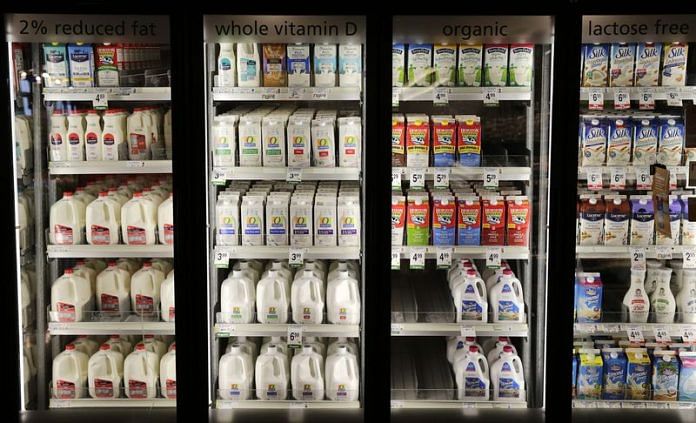By Julie Steenhuysen, Tom Polansek
(Reuters) -Some U.S. lawmakers urged the Biden administration on Friday to further contain the spread of bird flu in dairy cows as tests of milk suggested the outbreak is more widespread than previously thought.
The push from Congress members for a stronger response adds pressure on federal agriculture and health authorities still seeking to confirm how the H5N1 virus is spreading and its potential risks to people, one month after the first detection in a Texas dairy herd.
An analysis of U.S. Department of Agriculture data by a University of Arizona scientist offers new evidence that the first known H5N1 outbreak in dairy cattle is more far-reaching than the 33 herds in eight states that have officially tested positive.
“Containing this before it spreads among humans is critical. Given lessons learned from COVID, this federal response is insufficient,” Republican U.S. Senator Mitt Romney said in a post on X.
Some lawmakers, including Romney, have made a bipartisan push to reauthorize legislation known as the Pandemic and All Hazards Preparedness Act that lapsed last year and is aimed at bolstering the nation’s response to pandemics and other public health threats. The recent spread of bird flu and the detection of H5N1 genetic materials in milk have increased some calls for action.
One person, a Texas farm worker, has been confirmed to have bird flu in the current outbreak following exposure to dairy cows. The patient suffered conjunctivitis.
The virus in the human case is significantly different from the bird flu virus samples taken from infected cattle that were made public by government officials last weekend, said Dr. Michael Worobey, an evolutionary biologist from the University of Arizona.
The difference between the genetic sequences of the worker’s virus and the 239 other samples provided indicate that “this was a very longstanding, widespread epidemic,” he told Reuters.
The Texas Animal Health Commission said it did not receive the location of the worker’s farm or obtain samples of that herd to test because of the person’s confidentiality.
“I think the sequences out there probably aren’t representative of everything that’s circulating,” said Dr. Richard Webby, a virologist at St. Jude’s Children’s Research Hospital in Memphis.
A CDC spokesperson said in an email “there are always some subtle changes in genetic sequences when flu viruses move from host-to-host,” but said data points to the virus emerging from birds to infect cows and then transmission to the human.
One in five commercial milk samples tested in a nationwide survey contained particles of the H5N1 virus, the U.S. Food and Drug Administration said late on Thursday. The agency said there is no reason to believe the virus found in milk poses a risk to human health.
“This says this virus has largely saturated dairy cattle throughout the country,” said Dr. Michael Osterholm, an infectious disease expert at the University of Minnesota.
Many infectious disease experts and government officials have said they believe the pasteurization process will inactivate the virus, also known as avian influenza. However, additional testing is needed to confirm that there is no infectious virus in the milk, the FDA said.
“I’m not worried about the milk itself,” said Samuel Alcaine, associate professor, of food science at Cornell University. “It does indicate that the virus is more widespread among dairies than we had previously thought.”
Osterholm said the developments suggest the U.S. should be doing much more sampling, in both dairy and beef cattle, as well as pigs, which are a frequent mixing vessel for flu viruses that can be transmitted to people.
Both the Centers for Disease Control and Prevention and the World Health Organization said on Friday that the current overall public health risk is low, but is higher for those with exposure to infected animals.
Democratic U.S. Senator Tammy Baldwin of Wisconsin, a significant dairy state with no reported cases, has urged the USDA to “quickly deploy additional resources in states that have the opportunity to prevent the disease from entering herds.”
The White House has said that it is monitoring the avian flu situation, launching an “immediate response team” to ensure the safety of the nation’s food supply, monitor trends to mitigate risk and prevent the virus’ spread.
Starting on Monday, the USDA will require dairy cows to test negative for bird flu before they are moved across state lines.
In Indiana, officials are weighing their own potential restrictions, such as testing within the state, though it has no confirmed cases, said Bret Marsh, the state veterinarian.
“We’re taking a look here at the state level to see what we may need to do,” he said on a conference call.
(Reporting by Julie Steenhuysen and Tom Polansek in Chicago; Susan Heavey, Richard Cowan and Trevor Hunnicutt in Washington; and Leroy Leo and Bhanvi Satija in Bengaluru; Editing by Tasim Zahid and Josie Kao)
Disclaimer: This report is auto generated from the Reuters news service. ThePrint holds no responsibilty for its content.



